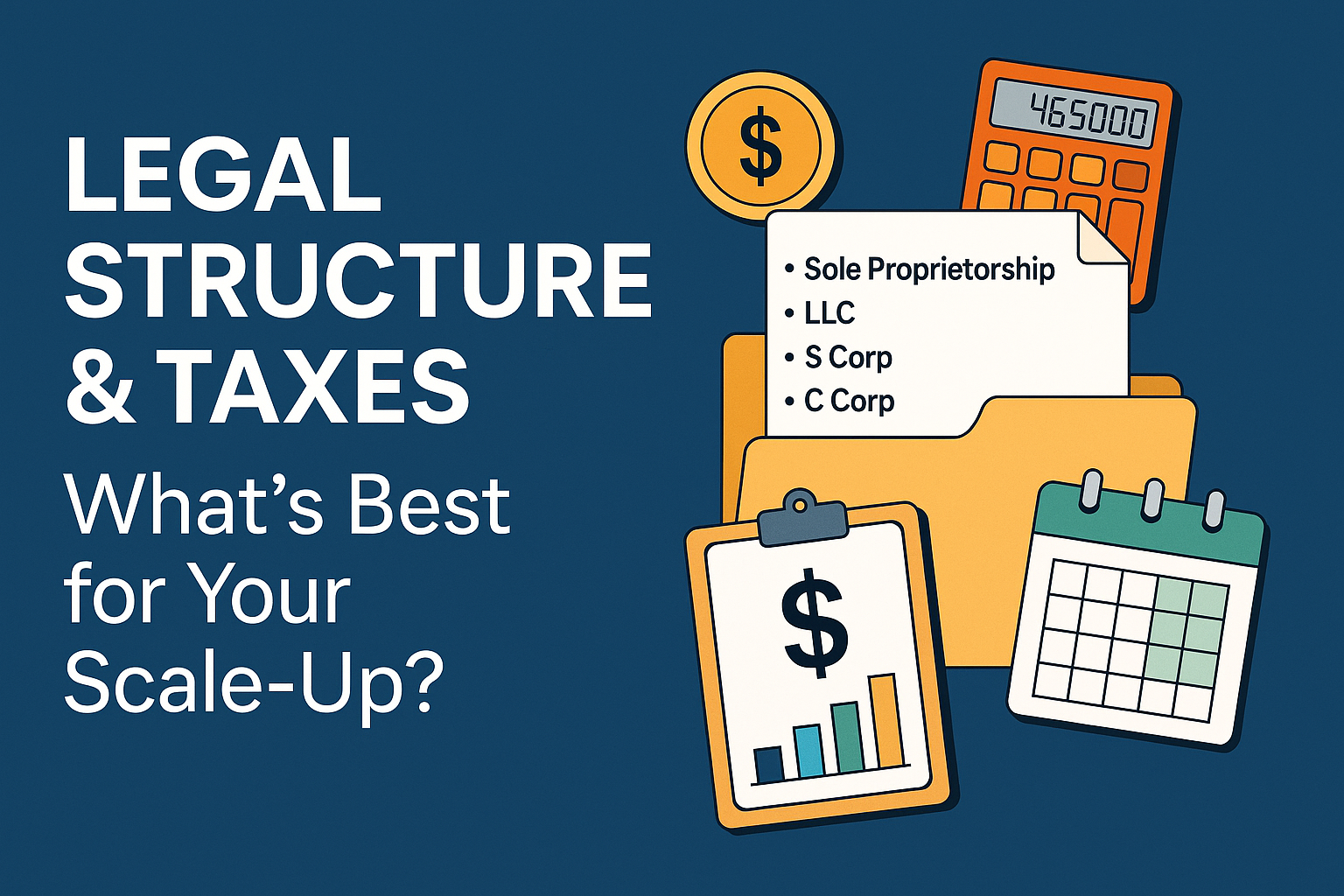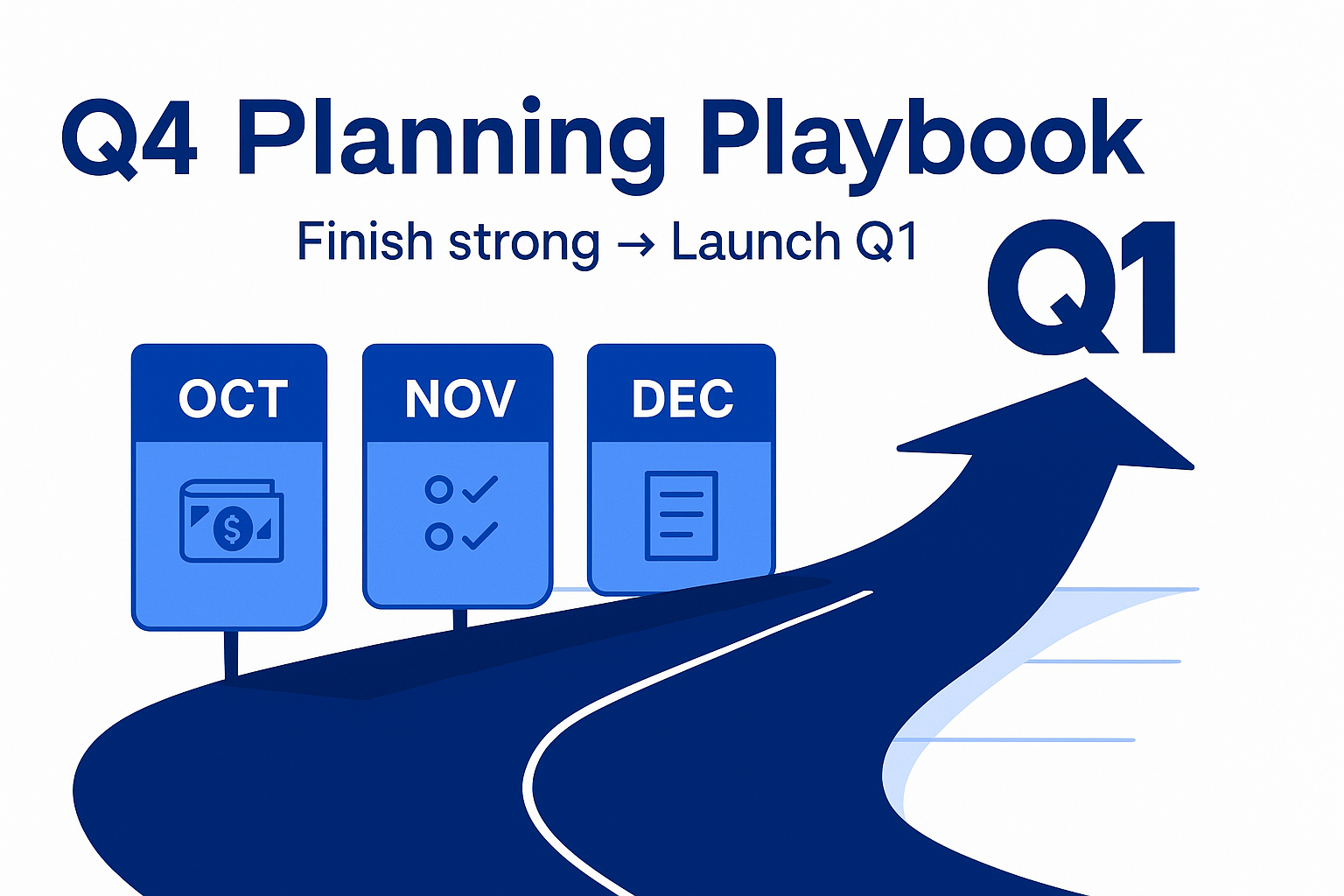
Making the right legal entity choice for my business
Choosing the right legal entity is one of the highest-impact decisions a founder makes after achieving product-market fit. The structure you lock in today steers tomorrow’s tax bill, fundraising options, liability exposure and administrative overhead. This guide walks scale-ups through the four most common entities: sole proprietorship, LLC, S corporation and C corporation, then maps each to the tax and growth realities you will face between $1 million and $50 million in annual revenue.
1. Comparing Entity Types: Sole Proprietorship vs. LLC vs. S Corp vs. C Corp
| Feature | Sole Proprietorship | Single-Member LLC | S Corporation | C Corporation |
|---|---|---|---|---|
| Liability shield | None | Strong | Strong | Strong |
| Federal tax form | Schedule C | Schedule C or 1120S/1120 | 1120S | 1120 |
| Self-employment tax | 100 % of net income | 100 % unless S-corp election | Only on wages | None (payroll tax on wages) |
| Investor-ready stock | No | No | One class, ≤100 shareholders | Multiple classes, unlimited shareholders |
| Fringe benefits | Personal deductions | Personal deductions | Limited | Full, deductible |
| Setup cost | $0 | $100-$500 state filing | $100-$500 + payroll setup | $250-$2 000 + securities counsel |
1.1 Liability Protection and Tax Implications
Sole proprietorship
Fast and free to start, but personal assets sit in the line of fire for lawsuits or debts. Every dollar of profit is hit with income tax plus 15.3 % self-employment tax.
Single-member LLC
Gives the legal shield without changing the tax picture—unless you elect corporate treatment. Default tax classification is still “disregarded entity,” so Schedule C filing continues.
S Corporation
After filing Form 2553, the entity becomes a pass-through that can split owner income into “reasonable salary” (subject to payroll taxes) and “distributions” (not subject to self-employment tax). The savings start around $60 k of net profit and scale quickly.
C Corporation
Pays its own federal tax (21 % for 2024-2025). Shareholders pay again on dividends (double taxation). The trade-off is simplified cap-table mechanics for institutional investors and the ability to grant ISOs and RSUs under standardized plans.
2. Tax Classification Options: Single-Member LLC Default vs. S Corp Election vs. C Corp Charter
2.1 Single-Member LLC Default
By default the IRS ignores the LLC. Pros: no extra return, losses flow to Schedule C. Cons: every dollar of profit is subject to self-employment tax. Works well for side gigs or very early stage startups still validating revenue.
2.2 LLC Electing S Corporation Status
File Form 2553 by March 15 of the tax year (or within 2.5 months of formation).
Break-even math: if owner salary + distributions ≥ $60 k–$80 k, payroll-tax savings usually outweigh extra payroll admin costs (~$1 200/yr).
Best practice: set payroll through Gusto or Rippling, run monthly distributions via ACH, document board minutes.
2.3 When a C Corporation Makes Sense
Seed stage is not too early if:
- You plan to raise priced equity rounds (SAFEs convert into preferred stock).
- You want to issue qualified small business stock (QSBS)—capital gains exclusion up to $10 million after 5 years.
- You need stock option pools with ISO/NSO flexibility for key hires.
- You will hire remote employees in multiple states—C-corp payroll is simpler for venture-backed companies.
3. Year-Round Tax Obligations for Scale-Ups
3.1 Estimated Quarterly Payments
| Entity Type | Form | Deadline | Calculation shortcut |
|---|---|---|---|
| Sole prop / LLC default | 1040-ES | Apr 15, Jun 15, Sep 15, Jan 15 | 110 % of prior-year tax safe harbor |
| S Corp | 1120-S + K-1 | Mar 15 (or extended Sep 15) | 100 % current-year estimate |
| C Corp | 1120 | Apr 15 (or extended Oct 15) | 100 % current-year estimate |
Pro tip: sync quarterly estimates to real-time bookkeeping dashboards so cash-flow surprises are caught early.
3.2 Sales Tax, Payroll Tax, State Filings
- Sales tax nexus rules change every quarter—use Avalara or TaxJar APIs to auto-register in new states as you ship inventory.
- Payroll tax registers once per state; penalties start at $100 per missed filing.
- Annual franchise or gross-receipts tax (CA, NY, TX, WA) often dwarfs federal tax for high-revenue, low-margin businesses.
4. Strategies to Minimize Liability While Scaling
4.1 Salary vs. Distribution Planning for S Corporations
- Reasonable salary benchmark: Bureau of Labor Statistics median for the role in your metro area.
- Distribution timing: monthly or quarterly ACH transfers reduce risk of “disguised wages.”
- Retained earnings: leave 10 %–20 % in the corp to cover future payroll or equipment purchases.
4.2 Maximizing Retirement Contributions
| Plan | 2025 Contribution Cap | Who Pays | Notes |
|---|---|---|---|
| Solo 401(k) | $69 000 ($76 500 if age 50+) | Employer + employee | Must be in place by Dec 31 |
| SEP-IRA | 25 % of W-2 wages up to $69 000 | Employer only | Easy to set up after year-end |
| Defined-benefit plan | Actuarial calculation | Employer | Ideal for founders >40 with high income |
4.3 Section 179 and Bonus Depreciation
- Section 179 allows immediate expensing of up to $1 220 000 (2025 limit) of new or used equipment.
- Bonus depreciation drops to 60 % in 2025, 40 % in 2026—plan large purchases accordingly.
- Software licensing qualifies if off-the-shelf and placed in service during the year.
5. When to Revisit Your Structure
5.1 Revenue Milestones
| Annual Net Income | Typical Action |
|---|---|
| < $50 k | Stay sole prop or single-member LLC |
| $60 k–$150 k | Elect S corporation |
| > $250 k | Evaluate C-corp for QSBS + investor readiness |
5.2 Fundraising Milestones
- Pre-seed / Seed SAFEs: LLC is acceptable if investors are angels.
- Series A priced round: investors will almost always require C corporation + Delaware incorporation + 83(b) elections.
- Convertible note bridge: still works under S-corp, but cap-table complexity rises.
5.3 Geographic Expansion
- New state registrations trigger franchise tax and apportionment rules.
- Partner additions (co-founders, equity hires) often force a switch from single-member LLC to multi-member LLC or S-corp to avoid phantom income issues.
6. Action Checklist for Founders
- Run a break-even analysis comparing 2025 payroll-tax savings vs. S-corp admin cost.
- File Form 2553 by March 15 if electing S-corp status for 2025.
- Open business bank accounts and credit cards in the new entity name before income hits.
- Set up real-time bookkeeping (QuickBooks Online, Xero) to feed quarterly estimates.
- Schedule a mid-year entity review when revenue crosses $50 k or you sign a term-sheet.
7. Frequently Asked Questions
Q: Which business structure saves the most taxes for a six-figure online business?
A single-member LLC electing S-corp status typically cuts self-employment tax by 30-40 % once net income exceeds $60 k.
Q: Do I have to form a Delaware C-corp to raise venture capital?
Most U.S. VCs insist on Delaware C-corp for stock option pools and QSBS benefits, but some angel SAFEs still accept LLCs.
Q: What is the deadline to elect S-corp status for 2025?
File Form 2553 by March 15, 2025 (or within 2.5 months of formation) to start S-corp treatment this year.
Q: Can I switch from S-corp to C-corp later?
Yes. File Form 1128 (or check the box on Form 8832) to revoke S-corp status; the effective date can be prospective or retroactive under certain conditions.
Q: How long should I keep entity formation documents?
Keep articles of incorporation, bylaws, operating agreements and board minutes indefinitely. They are needed to prove QSBS eligibility and defend against audits.
8. Next Steps
Entity choice is not “set and forget.” As revenue, headcount and investor expectations rise, the right structure today can become tomorrow’s bottleneck. CleverProfits delivers U.S.-focused bookkeeping, tax planning, payroll and fractional CFO services so you meet every filing deadline and capture every deduction.
Book your call today and move into the next growth stage with confidence.
The Clever Writing Team
The CleverProfits writing team includes various team members in Advisory, Financial Strategy, Tax, and Leadership. Our goal is to provide relevant and easy-to-understand financial content to help founders and business leaders reach their true potential.
TABLE OF CONTENTS
- Accounting, annual tax obligations scale-ups, best business entity for startups, break-even analysis entity choice, C Corp for venture capital, Delaware C Corp for VC, Finance, fractional CFO services, franchise tax scale-ups, legal structure for scale-ups, LLC vs S Corp vs C Corp, payroll tax compliance, QSBS tax exclusion, quarterly estimated taxes, real-time bookkeeping integration, retirement contributions for founders, S Corp election benefits, Section 179 depreciation, sole proprietorship tax implications, stock option planning, tax classification options, Tax Planning, Tax Savings






